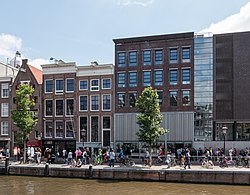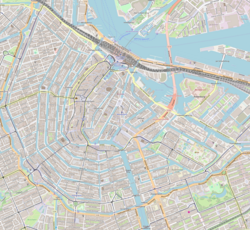Anne Frank House

Canal house and museum entrance in 2015
|
|
|
Location in the city center of Amsterdam
|
|
| Established | 3 May 1960 |
|---|---|
| Location |
Prinsengracht 263-265 Amsterdam, Netherlands |
| Coordinates | 52°22′31″N 4°53′02″E / 52.3753°N 4.884°ECoordinates: 52°22′31″N 4°53′02″E / 52.3753°N 4.884°E |
| Type |
Biographical museum Historic house museum |
| Visitors |
|
| Founder | Otto Frank |
| Director | Ronald Leopold |
| President | Wim Kok |
| Public transit access | Westermarkt Trams lines: 13, 14, 17 Bus lines: 170, 172, 174 |
| Website | www |
The Anne Frank House (Dutch: Anne Frank Huis) is a writer's house and biographical museum dedicated to Jewish wartime diarist Anne Frank. The building is located on a canal called the Prinsengracht, close to the Westerkerk, in central Amsterdam in the Netherlands.
During World War II, Anne Frank hid from Nazi persecution with her family and four other people in hidden rooms at the rear of the 17th-century canal house, known as the Secret Annex (Dutch: Achterhuis). Anne Frank did not survive the war, but in 1947 her wartime diary was published. In 1957, the Anne Frank Foundation was established to protect the property from developers who wanted to demolish the block.
The museum opened on 3 May 1960. It preserves the hiding place, has a permanent exhibition on the life and times of Anne Frank, and has an exhibition space about all forms of persecution and discrimination. In 2013 and 2014, the museum had 1.2 million visitors and was the 3rd most visited museum in the Netherlands, after the Rijksmuseum and Van Gogh Museum.
The house — and the one next door at number 265, which was later purchased by the museum — was built by Dirk van Delft in 1635. The canal-side façade dates from a renovation of 1740 when the rear annex was demolished. It was originally a private residence, then a warehouse, and in the nineteenth century, the front warehouse with its wide stable-like doors was used to house horses. At the start of the 20th century a manufacturer of household appliances occupied the building, succeeded in 1930 by a producer of piano rolls, who vacated the property by 1939.
...
Wikipedia

